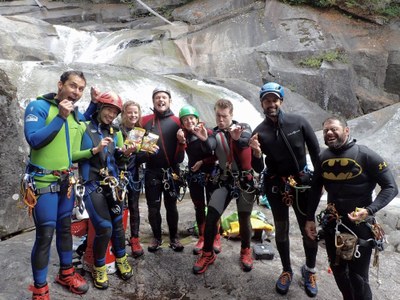
Clinic
Basic Canyoning Equivalency Assessment - Mountaineers Seattle Program Center
A process for experienced canyoneers to join The Mountaineers canyoning community.
- Tue, May 21, 2024
- Seattle Canyoning Committee
- Canyoning
- Adults
- Moderate
- $25.00 $50.00
- 4 (4 capacity)
- 4 (4 capacity)
- Cancellation & Refund Policy
Meet at the Seattle Program Center at 6:30PM
INTRODUCTION
We welcome canyoneers to our community who learned to canyon elsewhere. Whether to join our trips, or to take our Intermediate Course, we encourage experienced canyoneers to check out our equivalency process.
A benefit of joining Mountaineers trips is confidence in leader training as well as the training level of your entire team. Our goal is to have a transparent and low-barrier equivalency process, while ensuring the level of proficiency we expect of our participants.
Basic Equivalency is a good choice for canyoneers who are trained in releasable rigging and have training and experience in aquatic canyons. Those who successfully complete Basic Equivalency will be granted the Basic Canyon badge, which will allow them to join all Basic Canyon trips.
REQUIRED EXPERIENCE
- 5 unique aquatic canyons
- 10 total technical canyon descents
- Aquatic Requirements:
- Formal river-based whitewater training or canyon-specific whitewater training within the past 5 years -OR-
- Referral from a Mountaineers Canyon Leader
- Complete online orientation
- Complete technical assessment
HOW TO APPLY
Note: If applying to take the Intermediate Course, the Basic Equivalency application and technical assessment are incorporated in that course. Follow the process as outlined in the Intermediate Course.
General applications:
- Complete the short application
- Complete the short eLearning
- Complete the half-day technical assessment
TECHNICAL ASSESSMENT
ASSESSMENT OBJECTIVES
Students must be able to demonstrate proficiency in the following skills. Proficiency means you are a 4 out of 5 on the Mastery Hierarchy (1=failure, 2=insufficient, 3=sufficient, 4=proficient, 5=mastery). Proficiency = fluid execution, a clear understanding of concepts, quick self-correction, depth of knowledge, and includes application and supporting concepts.
ASSESSMENT
Participants will have a total of five (5) attempts to pass the three assessments. To pass, all must be completed without any major safety errors, and with a maximum of two minor safety errors.
- Single-Strand Conversion - Using a frog system with mechanical ascenders: ascend, pass a knot, convert to rappel, descend, pass a knot, rappel to ground, disconnect from the rope. Two points of contact must be maintained with the rope at all times. Methods of passing a knot such as passing the knot through a rappel device or using a VT prusik are not acceptable in this assessment.
- Anchor Rigging This assessment must be completed without any major safety errors, and with a maximum of two minor safety errors.
- Rig a retrievable traverse line from two unlinked bolts to access an unlinked bolted anchor
- Rig the unlinked bolts with an alpine draw. Rig releasable with an MMO, setting the rope length to 0-1' above the ground
- Clean the traverse line and anchor, rappel, and retrieve rope
- Gear Management & Communication Assessment
- Pack a rope bag with a BFK stopper knot tied at the bottom
- As anchor manager, rig a rappel with an EMO (eight mule overhand) style releasable 8 block & send a teammate down
- Communicate the following using only whistle and hand signals that you would like to:
- Send packs down on a zipline
- Work with a teammate to zip a bag down
- Clean, descend, and pull the rope
Badges
participants will earn:
Required Equipment
- Helmet
- Harness (canyon-specific or caving style harness preferred)
- Whistle
- Variable friction descender
- 2 safety lanyards made with dynamic rope with locking carabiners
- Alpine canyon quickdraw with a 60 cm sling and locking carabiners
- Footloop
- 4 working carabiners
- Grivel Vlad or other large carabiner to be used as a master carabiner in rigging
- Mechanical ascenders (Petzl Basic hand ascender and Croll chest ascender preferred)
- Figure 8 descender to be used as a rigging plate

 Basic Canyon Course
Basic Canyon Course